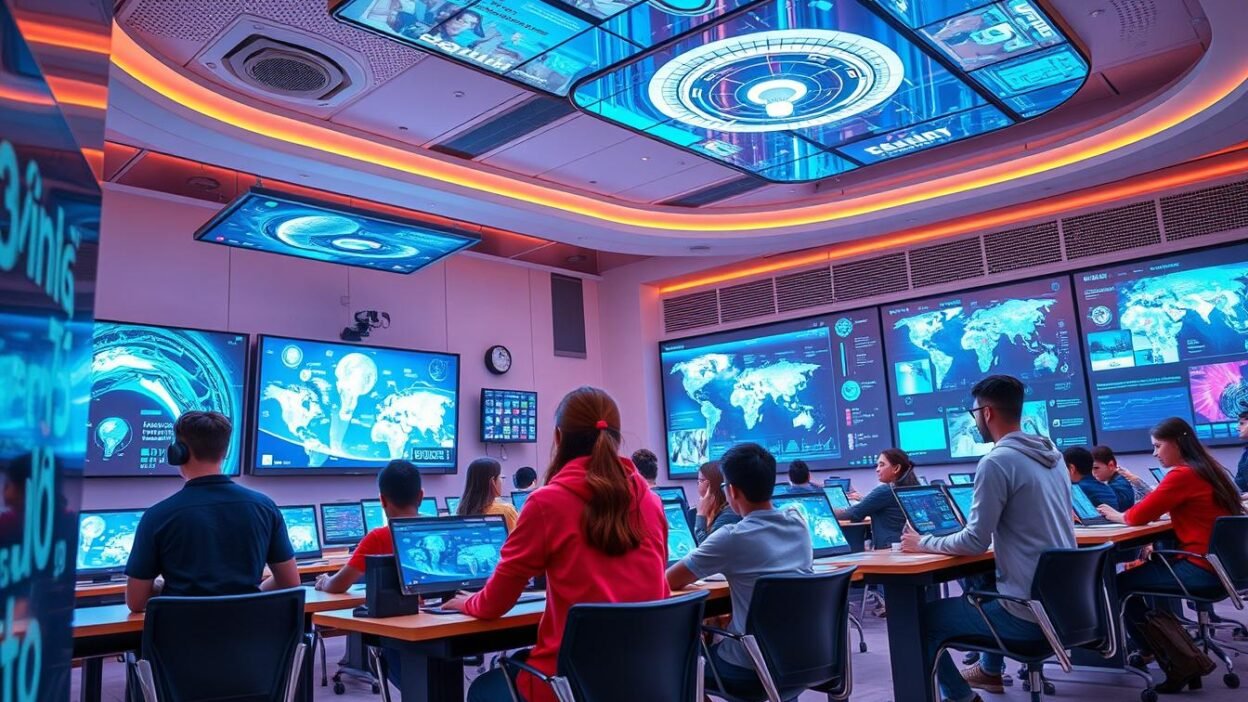Imagine a classroom that’s completely different from what we’re used to. E-Learning technologies are changing how we learn, fast. In India, online learning has grown by 300% after 2020. Old ways of teaching can’t keep up with today’s tech-savvy students.
But new tools like AI tutors and VR labs are changing the game. They offer fresh ways to learn. Now, educators and leaders are asking big questions. How can tech help fix education gaps in India? What tools will shape learning in the 21st century?
This article dives into the exciting trends in E-Learning. We’ll look at how AI and VR are making learning better. We’ll see how education is becoming more personal and global.
Preparing for the UGC NET exam can be a daunting task, but with the right resources, candidates can navigate the process effectively. Websites like MyJRF provide a comprehensive platform for aspiring educators, offering specialized guidance for UGC NET Paper 2 preparation and essential tips for acing UGC NET Paper 1. Additionally, understanding the revised syllabus provided by UGC is crucial for a targeted study approach. For official announcements and updates, candidates should regularly visit the UGC NET NTA portal, while the UGC’s job section and the main UGC website are invaluable for post-exam opportunities and academic resources. With these tools, candidates can maximize their preparation and set themselves up for success. Preparing for Paper 1 and UGC NET Paper 2 Education requires a strategic approach with quality resources. UGC NET Education aspirants can access structured video lectures that cover essential concepts comprehensively. For an in-depth understanding, check out teaching aptitude videos and research aptitude guidance to strengthen your foundation. Additionally, higher education system topics and communication skills preparation are crucial for scoring high. Explore logical reasoning tutorials and mathematical reasoning lectures for better problem-solving skills. Enhance your exam strategy with people, development & environment lessons and ICT in education modules. For previous year papers and practice sessions, explore mock test videos and exam strategy tips. Stay ahead in your preparation with teaching methodology insights and subscribe to Educators Plus for expert guidance.
Key Takeaways
- E-Learning technologies are breaking down barriers to education, with 75% of Indian schools going digital.
- AI and VR are key in modern teaching, boosting learning by up to 40% over old methods.
- Platforms like BYJU’S and Unacademy show how to teach millions of students well.
- Data analytics help track students’ progress, making learning more tailored to each one.
- Technologies are making digital classrooms accessible to all, including students with disabilities.
Introduction to E-Learning and Its Importance
E-learning changes how we learn and share knowledge. It uses digital tools and the internet. This includes virtual learning and distance learning, making learning possible outside of classrooms. We will look at what it is, its benefits, and how it affects education.
Understanding E-Learning
E-learning uses technology like learning management systems (LMS) and Massive Open Online Courses (MOOCs). Sites like Coursera and edX show how it works. Virtual learning uses simulations to mimic real life, while distance learning focuses on learning from anywhere. Both make learning more accessible and flexible.
Benefits of E-Learning
- Flexibility: You can learn at your own pace.
- Cost Efficiency: It saves money on school buildings and travel.
- Personalization: It adjusts to how you learn best.
The Role of E-Learning in Modern Education
| Traditional Education | E-Learning |
|---|---|
| Fixed classroom settings | Accessible via mobile devices and web browsers |
| Standardized curricula | Dynamic, updated content delivery |
| Geographic constraints | Global reach through distance learning |
In India, e-learning helps in areas where schools are scarce. It uses virtual learning platforms like BYJU’S and Unacademy. It doesn’t replace old ways but adds to them, making learning more accessible and inclusive.
The Rise of Artificial Intelligence in E-Learning
Artificial intelligence (AI) is changing e-learning by adding smart algorithms to learning systems. These systems study how learners behave to make learning better. This makes digital courses and online training more effective.
Schools use AI to make learning environments that change as learners progress. This means the content gets better matched to what each learner needs.
Personalized Learning Experiences
Platforms like Coursera and Udacity use AI to find out what learners don’t know. They watch how learners interact to adjust the learning material. For example:
- Adaptive assessments: Questions get harder or easier based on how learners do.
- Dynamic resource allocation: Learners get extra help on tough topics.
- Real-time feedback: Learners get instant feedback to improve faster.
AI-Powered Chatbots for Student Support
Chatbots like IBM Watson Assistant and Google Dialogflow act as virtual teachers. They help learners 24/7, remind them of deadlines, and explain things clearly. Here’s how they compare:
| Feature | IBM Watson | Google Dialogflow |
|---|---|---|
| Natural Language Processing | Advanced sentiment analysis | Contextual intent detection |
| Integration Capabilities | LMS compatibility | Mobile app optimization |
“AI chatbots reduce instructor workload by handling 30% of routine queries, freeing educators to focus on high-impact teaching.” — EdTech Research Collective 2023
AI makes learning more accessible, but there are worries about privacy and fairness. Schools need to be open about how they use AI to keep trust.
Mobile Learning: Learning on the Go
Mobile learning has changed how we learn by using smartphones and tablets. In India, over 800 million people use smartphones. This has opened up education to more people. Sites like Coursera and BYJU’S show how remote training and web-based learning can help many.
Advantages of Mobile E-Learning
There are many benefits:
- Ubiquitous access: You can learn anytime, fitting into India’s busy lives.
- Contextual engagement: Apps like Khan Academy make learning fun during breaks.
- Cost efficiency: It saves money by not needing lots of classrooms.
“Mobile learning’s adaptability improves knowledge retention by 30% through microlearning bursts,” states a 2023 UNESCO study on digital education adoption.
Popular Mobile Learning Apps
Top platforms use different teaching methods:
- Coursera: Works with universities to offer remote training through videos and quizzes.
- BYJU’S: Uses AI to make learning fun for kids with quizzes.
- Udemy: Provides web-based learning that works offline, great for areas with bad internet.
But, there are also challenges. Not everyone has good internet in rural areas. Apps don’t always work well on all devices. Teachers need to make sure learning is easy to access everywhere. This mix of new ideas and practical solutions will shape the future of mobile learning.
Gamification: Making Learning Fun
Gamification turns learning into fun by adding game-like elements. It uses psychology to make E-Learning and internet classes more engaging. By using points, badges, and leaderboards, teachers create systems that reward effort and keep students interested.
Elements of Gamification
Key parts include:
- Points and Badges: Mark achievements with numbers and symbols.
- Leaderboards: Encourage friendly competition among learners.
- Narratives: Use stories to give lessons context and purpose.
- Adaptive Challenges: Change difficulty levels based on how well you do.
There are two main types of gamification. Structural gamification adds game elements to existing courses. Content gamification turns lessons into games. Both methods aim to make learning more engaging and meaningful.
Successful Examples of Gamified E-Learning
Duolingo teaches languages through points. In India, BYJU’S uses game-like modules in internet classes, boosting retention by 40%. IBM’s “SkillsBuild” trains employees with simulated scenarios, showing success across ages.
A 2023 study by EdTech India showed gamified E-Learning in STEM fields boosted student interest by 65%.
“Gamification is not about games—it’s about humanizing technology,” noted Dr. Jane McGonigal, a leader in game-based learning.
Yet, there are challenges. Too many rewards can harm motivation. Also, cultural differences must be considered in internet classes for diverse groups. Finding the right balance ensures gamification enhances learning, not just adds fun.
Virtual and Augmented Reality in Education
Virtual and augmented reality (VR/AR) are changing education by adding sensory experiences to online education. These technologies let students work with 3D models and historical simulations. They also create virtual spaces for collaboration, making learning more engaging.
VR/AR connect abstract ideas with real-world experiences. This makes learning in STEM, humanities, and vocational fields more effective.
Immersive Learning Experiences
Studies show VR can improve memory by 40% compared to old teaching methods. AR, like in engineering, lets students see molecular structures in real settings. Key points include:
- Presence: Feeling like you’re there in virtual spaces
- Spatial Memory: Better recall through 3D exploration
- Multisensory Integration: Using sight, sound, and touch together
Case Studies of VR and AR in E-Learning
| Discipline | Application | Outcome |
|---|---|---|
| Medical Education | VR surgical simulations | 90% reduction in procedural errors reported in Indian medical schools |
| Architecture | AR building design visualization | 60% faster project completion at IIT Madras |
| History | AR historical site reconstructions | Student engagement increased by 75% in CBSE schools |
In India, challenges remain: 60% of schools face high costs for hardware, and 40% struggle with content creation. Yet, tools like Immerso VR and Google Expeditions AR offer solutions. A 2023 NASSCOM report shows 72% of Indian universities now focus on AR/VR labs.
As mixed reality and haptic feedback improve, they will make learning even more real and effective.
“Immerso VR’s partnership with AIIMS reduced surgical training costs by 30% through reusable virtual dissection modules.” – Dr. Rajesh Mehta, NIT Rourkela
By using these tools, teachers can create virtual classrooms where students explore quantum physics or ancient civilizations. This marks a new era of hands-on learning.
Social Learning: Collaboration and Community
Social learning theory shows how we learn from each other. In online learning, working together is like Vygotsky’s zone of proximal development. Here, learners help each other grow. Online training sites now focus on tools that help this teamwork, fitting India’s varied schools.
Building Knowledge Through Peer Exchange
Learning by solving problems together is key. In India’s colleges, Moodle uses forums for students to talk about ideas. Peergrade helps improve skills through feedback. A 2023 study in the Indian Journal of Education Technology shows learning together can increase retention by 34%.
- Discussion boards: Let people share ideas from anywhere
- Collaborative documents: Google Workspace lets everyone edit at the same time
- Virtual study groups: Zoom Breakout Rooms bring classroom feel online
Challenges in Digital Collaboration
“Making sure everyone gets a chance to share is key in online learning,” says Dr. Anika Mehta, IIT Bombay education researcher. “We need to understand cultural differences and make sure everyone can connect.”
Indian schools using online learning face big challenges. 42% of rural students struggle to join in, as shown by 2024 NITI Aayog data. To help, teachers use special exercises and support in many languages. Mixing online learning with face-to-face help seems to work well.
Microlearning: Bite-Sized Education
Microlearning changes how we learn by focusing on short, focused content. It’s based on how our brains work in today’s digital world. For schools in India, it helps make digital courses more accessible, even where internet is not always reliable.
The Effectiveness of Microlearning
Studies show microlearning works well because it reduces information overload and uses spaced repetition to improve memory. The Indian Institute of Technology found that microlearning boosts skill retention by 40% compared to traditional methods. The main benefits are:
- 20-30 minute sessions that fit well with multitasking learners
- 15–30% faster learning in specific skills
- Works well for both formal and informal learning
Platforms Offer Microlearning
| Platform | Key Features | Indian Relevance |
|---|---|---|
| Coursera | 1-2 hour modules from top universities | Partnerships with IITs for STEM micro-degrees |
| UpGrad | Project-based microcredentials | Focus on employability-driven IT courses |
| Byju’s | Interactive video snippets | Leverages vernacular language support |
| Unacademy | Live micro-lectures | Popular for competitive exam preparation |
“Microlearning’s adaptability makes it a critical tool for India’s diverse educational landscape, where 65% of learners access digital courses via mobile devices.” — National Education Policy 2023 Report
To make microlearning work, it’s important to balance short content with a broader curriculum. Schools should use it wisely: pair short modules with assessments and track progress with tools like Moodle. This approach helps India scale up distance learning and tackle the digital divide by making learning mobile-friendly.
Learning Analytics: Data-Driven Insights
Learning analytics changes how we teach by turning data into useful plans. It helps teachers make online learning better and improve student results. This is done by carefully looking at the data.
How Learning Analytics Enhance Education
Data analysis looks at how students learn in four ways:
- Descriptive analytics: It watches things like how often students log in and finish quizzes.
- Diagnostic analytics: It finds out why some students don’t engage with certain parts of online courses.
- Predictive analytics: It guesses which students might struggle based on past performance.
- Prescriptive analytics: It suggests ways to help students, like giving them content that fits their needs.
Tools for Measuring Learning Outcomes
Places use special tools to analyze data:
| Tool Type | Functionality | Application |
|---|---|---|
| Log Analytics Platforms | Track user interactions in LMS systems | Identify drop-off points in web-based learning |
| Predictive Modeling Systems | Machine learning algorithms for trend forecasting | Anticipate student attrition in online programs |
| Visualization Dashboards | Interactive data representation tools | Facilitate decision-making in blended learning ecosystems |
In India, places like the National Institute of Open Schooling use these tools. They follow rules for digital learning. But, they also make sure data is kept safe and everyone has access to learning tools.
Cloud-Based E-Learning Solutions
Cloud-based platforms change how we learn by making education more accessible and affordable. They help schools grow and reach more students without spending a lot. In places like India, where resources are limited, cloud tech is a game-changer. It lets schools use advanced tools without needing a lot of physical space.
Benefits of Cloud Technology in Education
Cloud tech brings big changes through three main services:
- Infrastructure-as-a-Service (IaaS): Gives schools the power to host big courses.
- Platform-as-a-Service (PaaS): Helps create special learning tools.
- Software-as-a-Service (SaaS): Offers tools like virtual classrooms and learning management systems.
These services cut down on upfront costs and make it easier for students to work together, no matter where they are. They also make it easier to update courses and track how well students are doing.
Major Cloud E-Learning Providers
Top providers offer cloud solutions made just for schools:
| Provider | Service Model | Key Features |
|---|---|---|
| Google Workspace for Education | SaaS | Integrated virtual classrooms, global collaboration tools, and automated grading systems. |
| Moodle Cloud | PaaS | Customizable LMS with LTI integration and multilingual support for diverse user bases. |
| Microsoft Azure Education | IaaS/PaaS | Scalable infrastructure for hosting large-scale remote training programs and AI-driven analytics. |
Setting up these systems means dealing with issues like data privacy and making sure everyone has internet access. Schools also need to think about how dependent they are on these services. For India’s growing education tech scene, these tools are key to reaching more students and improving education quality.
The Role of Video Content in E-Learning
Video content is key in today’s E-Learning systems. It uses both visuals and sounds to help learners remember more. Studies show that videos help learners process information better by combining words and images.
In India, videos help with different languages and reach students in rural areas. They adapt to fit the needs of various learners.
It’s important to know how to keep students engaged with videos. A 2023 study from IIT Bombay showed that short, interactive videos can increase retention by 40%. Here are some video types and their roles in learning:
Engaging Students with Video
- Lecture Captures: Great for explaining complex ideas, these videos feel like being in class but let you pause and review.
- Animated Explainers: Use animations to make hard topics easier to understand, like in biology, and reduce confusion.
- Interactive Scenarios: In training for healthcare, these videos let learners make choices, which helps them think critically.
Best Practices for Educational Videos
| Production Element | Implementation Guideline |
|---|---|
| Duration | Keep it short: 5-7 minutes for kids and teens, 10-15 minutes for college students. |
| Accessibility | Add subtitles in many Indian languages and SDH for the deaf and hard-of-hearing. |
| Technical Optimization | Use streaming that adjusts to internet speeds in rural areas. |
Institutions like NPTEL and SWAYAM use videos in many languages. But, 34% of rural users face slow loading. They need special codecs like AV1. It’s important to focus on teaching goals, not just using new tech.
Addressing Accessibility in E-Learning
Accessibility in e-learning is key to fair online training for all. In India, making educational sites work for everyone is essential. Laws like India’s Rights of Persons with Disabilities Act (2016) and global standards like WCAG 2.1 make this a must.
Importance of Accessibility Standards
Universal design makes content easy for everyone to use. For example, subtitles in virtual learning help deaf learners and those who speak different languages. It’s important to make sure everyone can use the content, not just those with disabilities.
A 2023 UNESCO report shows that making content accessible helps all learners, not just those with disabilities. This makes learning better for everyone.
Tools and Resources for Inclusive Learning
Tools like Blackboard Ally check if course materials are accessible. Articulate Storyline makes it easy to add alt-text and screen-reader options. Assistive technologies, like Google Read&Write, help with text-to-speech and translations.
Sites need to work well even in areas with slow internet. Tools like Kaizena help make content easy to use for everyone.
“Inclusive design isn’t an add-on—it’s the backbone of equitable education.”
But, there are challenges like training teachers and fixing old systems. Places like IIT Bombay are leading the way with accessible MOOCs. They use sign-language interpreters and adjustable font sizes.
By focusing on accessibility, we can make online training better for everyone in India.
Future Predictions for E-Learning Technologies
E-learning is changing fast, thanks to new tech. For schools in India, this means better learning for everyone. Tools like generative AI, extended reality, and blockchain are leading the way.
Emerging Technologies on the Horizon
Generative AI will make creating content easier for teachers. It will also help understand how students feel, making learning more personal. With VR/AR, complex topics will become more real.
Blockchain will keep learning records safe. And quantum computing will make simulations even better. These tools are getting closer to being used in schools.
Preparing for the Future of E-Learning
Schools need to check if they’re ready for new tech. Using cloud platforms like Google Classroom helps grow with learning. It’s important to teach teachers how to use these tools well.
It’s also key to make sure tech is used right. This means keeping data safe and avoiding unfair bias. By doing this, tech can help everyone learn, not just some.
For India’s schools, finding the right mix of tech and teaching is essential. This way, technology helps make learning fair and effective for all.
FAQ
What is e-learning?
E-learning uses electronic means to access education outside a traditional classroom. It includes online courses, internet classes, and virtual classrooms. This way, students can learn from anywhere, making education more flexible.
How does e-learning benefit students?
E-learning offers many benefits. It allows students to learn at their own pace and costs less. It also makes learning more personal and accessible. This leads to better retention of knowledge through interactive content.
What technologies are driving the rise of e-learning?
Artificial intelligence, mobile devices, and cloud computing are key technologies. They make learning more personalized, accessible, and scalable. These innovations improve the quality and reach of online education.
What role does gamification play in e-learning?
Gamification makes learning fun by adding game elements. It uses points, badges, and leaderboards to engage students. This approach makes learning enjoyable and effective.
How can learners benefit from mobile e-learning?
Mobile e-learning is convenient and accessible. It lets learners study anytime, anywhere. This is great in areas with many smartphones, helping bridge educational gaps.
What is the impact of video content on e-learning?
Video content enhances e-learning by engaging learners through visuals and sound. Good educational videos are short, clear, and interactive. This boosts understanding and retention.
How do learning analytics improve educational outcomes?
Learning analytics uses data to improve teaching. It helps tailor learning to individual needs. This leads to better learning outcomes by making education more effective.
What should institutions consider when implementing cloud-based e-learning solutions?
Institutions should look at scalability, security, and compatibility. These factors ensure cloud technology benefits are maximized. They also help avoid risks.
What are some effective tools for social learning in e-learning environments?
Tools like collaborative platforms and discussion forums are effective. They help learners work together and share knowledge. This improves the educational experience.
Why is accessibility important in e-learning?
Accessibility makes education available to everyone, including those with disabilities. Following standards like WCAG ensures fair learning experiences. It meets diverse needs and preferences.





